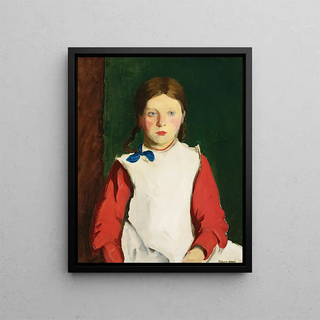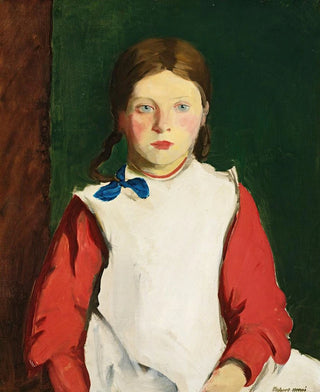Art print | Petite Irish girl - Robert Henri


View from behind

Frame (optional)
The "Petite fille irlandaise" art print by Robert Henri is a work that transcends a simple childhood portrait to become a true ode to beauty and innocence. Painted in the early 20th century, it captures the essence of an era while revealing the deep emotions of a young girl. The delicate light bathing the child's face and the vibrant colors composing the background invite the viewer to immerse themselves in a world of softness and nostalgia. Henri, an emblematic figure of the American realist movement, manages here to immortalize a fleeting moment, a gaze, an expression that resonate with rare emotional depth.
Style and uniqueness of the work
Robert Henri's style is characterized by a bold approach and an impressionist technique that allow him to capture life in all its splendor. In "Petite fille irlandaise," the artist uses fluid brushstrokes and contrasts of light to bring his subject to life. The young girl, dressed in a simple dress, is surrounded by an intimate atmosphere that emphasizes her innocence. The shades of green and blue blending harmoniously evoke Ireland's lush nature, while touches of red and orange add a palpable warmth to the overall scene. Henri does not merely depict a child; he evokes an emotional universe in which each viewer can see themselves, recalling their own childhood memories and dreams of lost innocence.
The artist and his influence
Robert Henri, born in 1865, is one of the most influential members of the Ashcan movement, which advocated a realistic and sometimes brutal representation of urban life. However, Henri was not limited to painting city scenes; he had a particular talent for capturing the human soul, as evidenced by this work. His artistic approach has inspired many painters, both in America and internationally, who sought to explore the psychology of characters through portraits. Henri believed in the power of art as a means of personal and social expression, and his legacy endures through generations of artists who continue to explore the themes of the

Matte finish

View from behind

Frame (optional)
The "Petite fille irlandaise" art print by Robert Henri is a work that transcends a simple childhood portrait to become a true ode to beauty and innocence. Painted in the early 20th century, it captures the essence of an era while revealing the deep emotions of a young girl. The delicate light bathing the child's face and the vibrant colors composing the background invite the viewer to immerse themselves in a world of softness and nostalgia. Henri, an emblematic figure of the American realist movement, manages here to immortalize a fleeting moment, a gaze, an expression that resonate with rare emotional depth.
Style and uniqueness of the work
Robert Henri's style is characterized by a bold approach and an impressionist technique that allow him to capture life in all its splendor. In "Petite fille irlandaise," the artist uses fluid brushstrokes and contrasts of light to bring his subject to life. The young girl, dressed in a simple dress, is surrounded by an intimate atmosphere that emphasizes her innocence. The shades of green and blue blending harmoniously evoke Ireland's lush nature, while touches of red and orange add a palpable warmth to the overall scene. Henri does not merely depict a child; he evokes an emotional universe in which each viewer can see themselves, recalling their own childhood memories and dreams of lost innocence.
The artist and his influence
Robert Henri, born in 1865, is one of the most influential members of the Ashcan movement, which advocated a realistic and sometimes brutal representation of urban life. However, Henri was not limited to painting city scenes; he had a particular talent for capturing the human soul, as evidenced by this work. His artistic approach has inspired many painters, both in America and internationally, who sought to explore the psychology of characters through portraits. Henri believed in the power of art as a means of personal and social expression, and his legacy endures through generations of artists who continue to explore the themes of the






